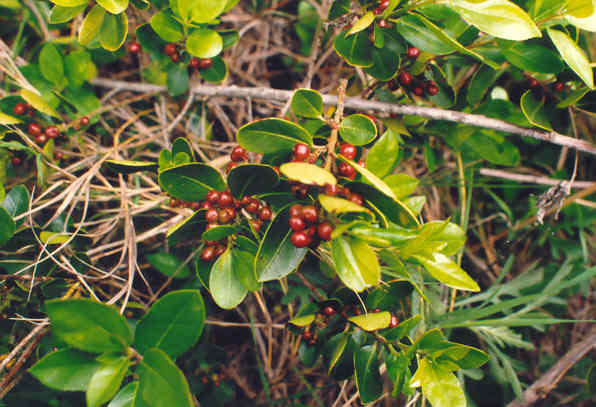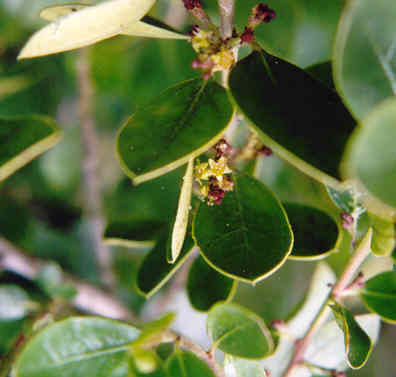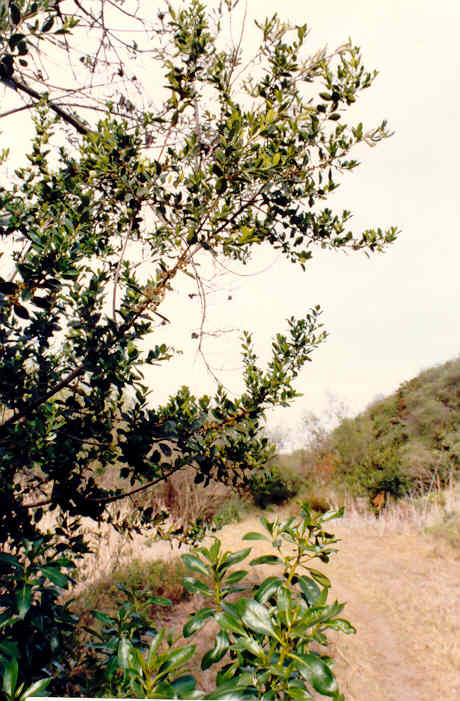
Rhamnus species # 1
 |
Rhamnus species # 1
Rhamnaceae (Buckthorn Family)Origin UnknownRhamnus |
March Photo
Plant Characteristics:
Evergreen nearly glabrous shrub, mature height unknown, presently +/- 5
m. tall; lvs. alternate, 3.5-(6.7) cm. long, 1.5-(3.8) cm. wide, broad-elliptic,
often mucronate, with a few gland-like hooked projections on margin, coriaceous,
dark green above, lighter below; petioles to 1.2 cm., with dense short white
hairs; stipules, awl-shaped, glandular, turning brown and dry early; infl.
dense, more or less pubescent; most fls. staminate only, some fls. bisexual,
5-merous, in axillary racemes; bracteoles ciliolate, usually caducous;
calyx-lobes lanceolate, glabrous, 2mm. long, acute, light green with flecks of
purple, fleshy; petals absent; anthers versatile, filaments +/- 1mm. long,
alternate with sepals; style 1, stigma 3; drupe 4-6 mm.,
fleshy, obovoid, reddish becoming black.
Habitat:
Escape from cultivation, complete habit unknown.
Blooms winter and early spring here.
(my comments).
Name:
Rham-nus, ancient Greek name.
(Bailey 645). Rhamnus was the name of a city in Attica, a region of
ancient Greece. Why it was chosen
by a botanist for use as a genus name is not known to us. (John Johnson).
General:
Rare in the study area, only one tree known and this in Big Canyon.
Keys to R. crocea using the key in Bailey p. 645 but it is not
this species of Rhamnaceae. (my comments).
The medicinal benefits of R. californica were known to the Indians
who are said to have used it to correct the effects of an acorn diet. The bark was formerly widely collected and exported to be
made into a laxative. It was hoped
that the berries would be a perfect substitute for coffee, but the flavor did
not live up to the shape of the berry. (Dale
168). R.
californica, Coffee Berry, is a laxative, containing emodin and other
rhamnoid glycosides; a teaspoon of the chopped bark boiled for ten minutes is a
starting dose, increased or decreased depending on its effects, which vary in
different localities. Coffee Berry
is especially useful for inflammatory rheumatism, where the joints are swollen
and painful. (Moore, Medicinal
Plants of the Mountain West 60).
The bark of R. frangula has been used as a purgative, diuretic and
emetic. It is a very effective
remedy for appendicitis. Not habit
forming. Will produce profuse
perspiration when taken hot. Take
both internally and apply externally as a wash.
The ointment made of buckthorn bark is very effective in curing itch. Expels worms. Will
remove warts. Good used as a
fomentation or poultice. (Kloss 210).
About 100 species, of almost worldwide distribution, some of considerable
medicinal value. (Munz, Flora
So. Calif. 738). See
Rhamnus species #2 for additional information on the genus.
(my comment).
Text Ref:
Bailey 644; Munz, Flora So. Calif. 738; Sunset Editors, New Western
Garden Book 1984 p.
441; Tutin, et al. Vol. II 244.
Photo Ref:
Feb-Mar 88 # 12,14,15; Mar-April 88 # 5A; Mar 95 # 21, May-June 00 #21;
Feb 05 #1.
Identity: by R. De Ruff,
confirmed by John Johnson.
First Found: February 1988.
Computer Ref: Plant Data 405.
Plant specimen donated to UC Riverside in 2004.
Last edit 8/5/05.
 |
 |
February photo January Photo